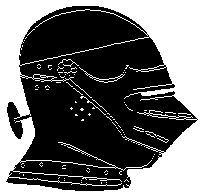 |
Isn't Chivalry Dead?!by Brian R. Price |
 |
Isn't Chivalry Dead?!by Brian R. Price |
| No indeed, chivalry is not dead! As an idea, chivalry's roots are tied to the fundamental Western values that bind our civilization, a culture that I am proud to be a part of. Chivalry is an idealization of virtue, a wedding of military excellence with courtesy, a sense of justice, piety, and honor. All of this is brought forward to us from a dark time in history, from days when men fought one another, fought the harsh world that had broken Roman order, fought against the plagues visited upon Europe, a troika of perils nearly destroying European culture. The idea of chivalry came out of this darkness like a phoenix; first in the glorification of the warrior virtues that Charlemagne used to unify Europe and dispel the encroachment of foreign religions and cultures. Men saw heroes as bringing them from the darkness, heroes like Charlemagne and Alexander. The idea of a man's greatness as seen through the eyes of these people is brought to us with potent energy in the Song of Roland, where Roland is glorified for his loyalty, prowess, and indomitable courage. As the feudal system was founded,the warrior (Latin--milites) became an important social figure, glorified in song and rewarded in land and revenue. These milites were a rowdy bunch, brawling and fighting amongst themselves as much as fighting for their peasants or their king. But there was some order, and this order began to reduce the barbarism that had been so much a part of life after the fall of Rome. During the 12th century, as society began to really settle, two important things happened to the ideals of what was first called "knighthood." First, the church, ever dominant in medieval affairs of morality, began to reshape the idea of the social warrior to its own ends. Knights were called to crusade, to be the "soldiers of God." The crusades were launched,the ideal put forward by the church sought to add new virtues to the potent strength of the warrior--that with God and Right on one's side, the sword arm itself was strengthened. The church added piety, justice, defense of the innocent and the weak, honesty, humility and purity. Alongside of this new "religious" chivalry, secular influences arose that had an equally strong say in the new reality of knighthood. The ideas of Courtly Love, under the patronage of Elanor of Aquitaine and her daughter Marie, created a new cult of adoration surrounding women. Encapsulated by Andreas Capallanus in The Art of Courtly Love, the central tenet in this school of thought was that through love the knight or lover could be strengthened. by the love of a woman. Not completely different from the ideals of religious chivalry, where the knight was strengthened by devotion to God. From the Courts of Love chivalry acquired courtesy, generosity, fidelity,and the respect & defense of women. Out of the Courtly Love movement came tales of romance, from which the legends of Alexander, Charlemagne, and Arthur hatched. These legends provided symbolic life to the ideals of church and court, building new heroes, measuring the knight by a new ideal standard. The symbols that have grown out of these legends are familiar to every young Westerner--King Arthur and the Round Table, Knights in Shining Armor, and not least, chivalry. In these tales chivalry was the idealization of each age; in each romance and in each treatise on knighthood the authors set down new standards that the knight was to be judged by. Chivalric virtues were a crystal clear distillation of what it meant to be a fine human being, a person in search of justice and humility. These standards grew and changed over time, until the knight perished and the idea of chivalry metaporphasized into the ideal of a virtuous "officer and gentleman." But the symbols of chivalry are powerful--powerful because of their deep attachment to the most important virtues of man. Courtesy, respect, generosity (largesse), honesty, fidelity, humility, justice, excellence (prowess), courage, loyalty, duty. These things are timeless. Attached to the bright symbols of knighthood, they are still transmitted down through the generations, striking a chord of need when times seem dark. Today, morality and ethics are rare commodities. Schools no longer teach morality; but religion is able to reach only a few and families are often broken. We see the results of this disjunction nightly on the television news, and yearn for a better world. It is into this vacuum that the symbols of chivalry bring both memories of an idealized past and the promise for a better future. For indeed under the pressures of life man has only morality to defend his soul from the ravages of the world. Medieval tournament re-enactments recall something of these days gone past, compelling virtuous conduct by the mechanism of reputation. Though I cannot speak for all, tournament re-enactments give license to try out being good in a very gray world, to work towards a distant ideal. Many young men and women start down this path, finding that it brings both pleasure and a sense of peace with their world. The peace comes from the shield of ethics that they first begin to develop on the tournament field, gradually expanding it by baby steps to encompass their entire philosophy of life. In this sense tournament fighting is indeed a Western martial art--an art with a very old philosophy that speaks to the heart, as well as to the mind. No indeed, chivalry is definitely not dead. Also see : A Code of Chivalry for Today
return to Arthurian Legend |
Webbed by Chronique: The Journal of Chivalry
© 1996 All material copyrighted by author unless otherwise noted.
Home
|